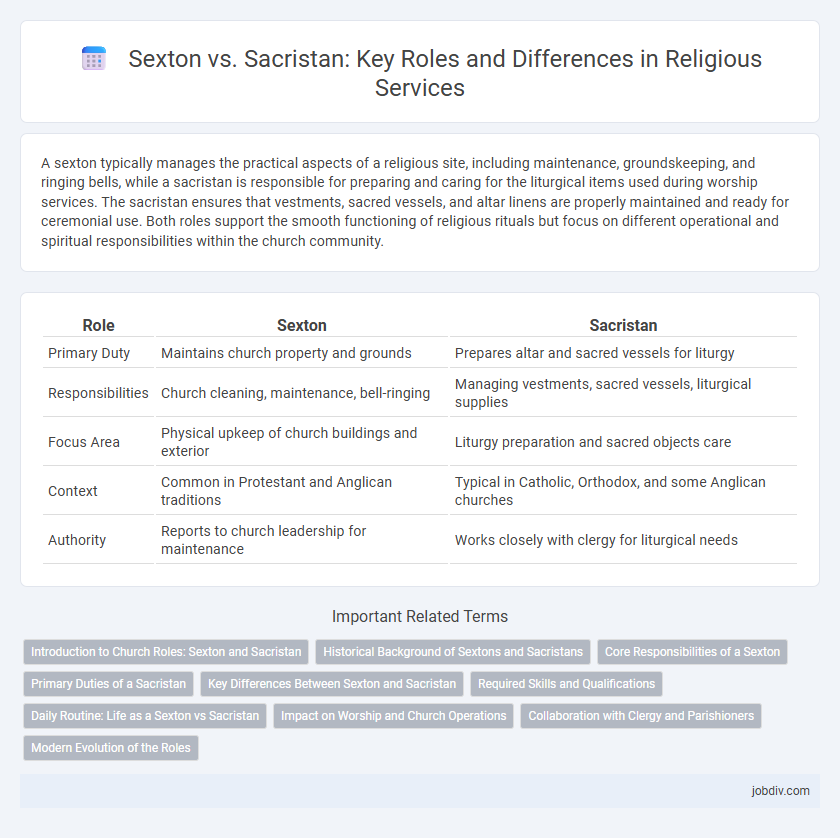A sexton typically manages the practical aspects of a religious site, including maintenance, groundskeeping, and ringing bells, while a sacristan is responsible for preparing and caring for the liturgical items used during worship services. The sacristan ensures that vestments, sacred vessels, and altar linens are properly maintained and ready for ceremonial use. Both roles support the smooth functioning of religious rituals but focus on different operational and spiritual responsibilities within the church community.
Table of Comparison
| Role | Sexton | Sacristan |
|---|---|---|
| Primary Duty | Maintains church property and grounds | Prepares altar and sacred vessels for liturgy |
| Responsibilities | Church cleaning, maintenance, bell-ringing | Managing vestments, sacred vessels, liturgical supplies |
| Focus Area | Physical upkeep of church buildings and exterior | Liturgy preparation and sacred objects care |
| Context | Common in Protestant and Anglican traditions | Typical in Catholic, Orthodox, and some Anglican churches |
| Authority | Reports to church leadership for maintenance | Works closely with clergy for liturgical needs |
Introduction to Church Roles: Sexton and Sacristan
The sexton manages the church property and grounds, ensuring maintenance and security, while the sacristan is responsible for preparing the sanctuary, vessels, and vestments for liturgical services. Both roles support the smooth operation of church activities but differ in their focus, with the sexton emphasizing physical upkeep and the sacristan focusing on sacred objects and ceremonial readiness. Understanding these distinct responsibilities highlights the organized structure within religious communities.
Historical Background of Sextons and Sacristans
Sextons and sacristans have roots tracing back to early Christian communities where maintaining church property and sacred objects was essential for worship. Sextons traditionally oversaw the care of church buildings and grounds, including bell ringing and grave digging, with their duties evolving during medieval times to include various parish responsibilities. Sacristans, by contrast, primarily managed the sacristy and sacred vessels, a role documented in early church hierarchy as crucial for the preparation of liturgical services.
Core Responsibilities of a Sexton
A sexton is primarily responsible for the maintenance and care of church property, including buildings, grounds, and cemetery. Core responsibilities include preparing the church for services, managing utility systems, and overseeing security measures. Sextons also handle setup and cleanup for religious events, ensuring a respectful and orderly worship environment.
Primary Duties of a Sacristan
The primary duties of a sacristan include preparing the altar for religious services, ensuring the proper care and maintenance of sacred vessels, vestments, and liturgical objects. They arrange the liturgical books, candles, and other necessary items for Mass and other ceremonies. Sacristans also oversee the cleanliness and orderliness of the sacristy and worship space to support the smooth conduct of liturgical functions.
Key Differences Between Sexton and Sacristan
The key difference between a sexton and a sacristan lies in their specific duties within a religious setting; a sexton primarily manages the maintenance of church property and grounds, ensuring cleanliness and order. In contrast, a sacristan is responsible for the care of sacred vessels, vestments, and liturgical items, preparing the altar and assisting clergy during worship services. Both roles are essential for the smooth operation of religious ceremonies but focus on different aspects of church administration and ritual preparation.
Required Skills and Qualifications
A sexton requires strong organizational skills, basic maintenance knowledge, and the ability to manage church property and grounds effectively. A sacristan must possess detailed knowledge of liturgical practices, careful attention to sacred vessels and vestments, and expertise in preparing for religious services. Both roles demand reliability, respect for religious traditions, and effective communication skills within the church community.
Daily Routine: Life as a Sexton vs Sacristan
A sexton typically manages the maintenance and security of church property, including ringing bells, preparing the site for services, and overseeing graveyard care, with daily tasks centered on facility upkeep and practical logistics. A sacristan's routine involves preparing the sanctuary for worship, arranging liturgical items such as vestments, vessels, and altar linens, as well as ensuring the proper conduct of sacred rituals. Both roles support the church's daily operations but diverge with the sexton focusing on physical maintenance and the sacristan on liturgical preparation.
Impact on Worship and Church Operations
Sextons enhance worship by maintaining church facilities, ensuring a clean and orderly environment that supports spiritual focus and safety during services. Sacristans directly influence worship by preparing liturgical items and vestments, facilitating smooth rituals and ceremonies integral to religious observance. Together, these roles optimize church operations, balancing logistical upkeep with ceremonial precision to enrich the overall worship experience.
Collaboration with Clergy and Parishioners
Sextons and sacristans play complementary roles in supporting clergy and parishioners within a religious community, fostering seamless collaboration through their distinct responsibilities. Sextons typically oversee the maintenance of church property and grounds, ensuring a welcoming environment, while sacristans manage sacred vessels and prepare the altar for worship, directly assisting clergy during liturgical services. Their coordinated efforts enhance the spiritual experience by maintaining both the physical space and the ritualistic elements essential for worship.
Modern Evolution of the Roles
The roles of Sexton and Sacristan have evolved significantly in modern religious practice, with the Sexton increasingly focusing on facility management and community coordination, reflecting the growing complexity of church operations. Sacristans, traditionally responsible for the care of liturgical items and preparation of the altar, now often incorporate technology and digital inventory systems to maintain sacred objects efficiently. This shift demonstrates a broader trend toward professionalization and specialization within church staff, enhancing both spiritual and administrative functions.
Sexton vs Sacristan Infographic

 jobdiv.com
jobdiv.com